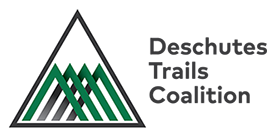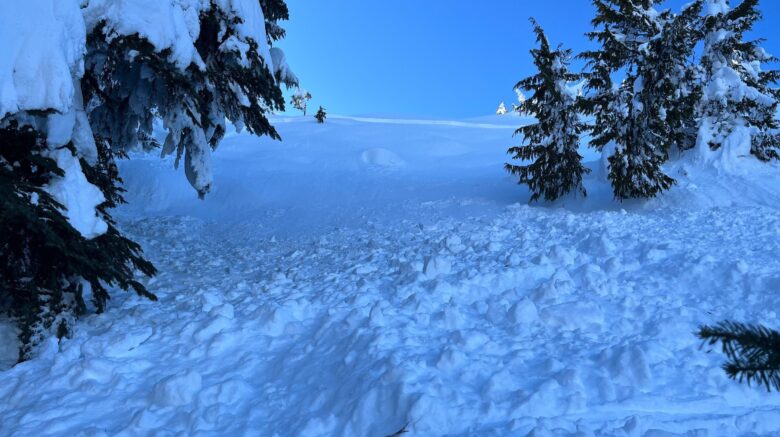Sunny, with a Chance of Slides.
Backcountry Snow Safety in Central Oregon
Winter’s first snow dumps came later this year, but the Central Oregon Cascades backcountry snow season is now in full swing. With ample snowpack back in the hills, things feel ‘back to normal’, grabbing our water bottle as an afterthought as we head out as fast as we can. It’s easy to not take these on-snow adventures right out our back door very seriously. With peaks and trails so easily accessed from Bend, it can be easy to misjudge…or forget…that winter conditions still warrant a little respect.
Every winter, Deschutes County Search and Rescue consistently performs a handful of monthly rescues; Some misevaluate their abilities or fitness, and can’t make it back. Some get lost. Others injure themselves. Even the most-seasoned or skilled can have a bad day, and Northwest weather often means unpredictability, too. Keeping all of these variables in mind, it doesn’t hurt for all of us to have a little refresher on winter backcountry safety.
Best Practices for Backcountry Safety in the Central Oregon Cascades
Concerns like avalanche danger may seem reserved for a certain subset of motivated skiers, boarders and backcountry enthusiasts, but it’s important to remember that snowshoeing or winter hiking adventures in the backcountry require awareness and preparation, too. Two main factors to consider when evaluating risk level are recent weather conditions’ impact on snow, and the nature of the slope/terrain.
Gabriel Coler is a forecaster for the Central Oregon Avalanche Center, a non-profit started in 2009 that serves as a resource both for timely avalanche forecasts and observations, as well as promoting avalanche awareness through education.
“The majority of avalanches in Central Oregon occur during and immediately following storms,” Coler said. “So, stormier winters tend to have more avalanches.”
Conditions that accompany storm cycles can be high winds, which can increase “load” on certain aspects of terrain and make them more prone to “slabbing”, which sets up a common slide scenario. Plus, in classic Northwest fashion, along with a healthy dose of climate change, highly variable weather patterns play a huge part in the avalanche safety equation. Freeze-thaw cycles can impact the snow’s stability, sometimes creating layers deeper below that act almost like ball bearings, allowing the snow above to shear and slide.
The team at Central Oregon Avalanche Center said that many take for granted that slides can’t happen, even in popular places like Tumalo Mountain and Pole Buttes, which are easily accessed from popular Dutchman Sno-Park.
“People think that it doesn’t slide there, but it does,” said Zoe Roy of COAC. The most dangerous slopes in Central Oregon are steep slopes that are located at treeline.
“People are able to access steep slopes located at treeline like Paulina Peak and Tam Rim during storms, and these slopes can be just as dangerous as higher elevation slopes because they receive the same wind and snowfall amounts,” Coler said. “Our most recent (the last 15 years or so) fatalities in Central Oregon include two deaths at Newberry Crater and one at Mt Bailey.”
Popular Sno-Parks Near Bend and Avalanche Danger
COAC cautions skiers and snowshoers alike to not mistake accessibility with stability. When asked what slopes to keep in mind in the Central Oregon area, they said that even the roadside, easy-access slopes out of Vista Butte Sno-Park can be steep enough to present some safety concerns. The frequented slopes of Tam McArthur Rim (out of Three Creek Sno-Park) are indeed “friendly” for backcountry turns, but also fall within the degree-angle “danger zone” for avalanches. And, seemingly benign and beautiful Paulina Peak near LaPine actually sees the most fatalities in the area.
Slope Danger-Zone In addition to terrain features like gullies or cornices, the best basic backcountry rule of thumb one can use to evaluate terrain is the degree angle of the slope:

PACK THE TEN ESSENTIALS, PLUS A FEW EXTRA WINTER ONES
And, of course, in addition to avalanche awareness, always practice emergency preparedness before heading out the door. This is a great handy list provided by the Washington Trails Association:
The Ten Essentials include a topographic map and compass, hydration, extra food, extra clothing, a fire starter, a first-aid kit, a pocket knife, a flashlight, sun protection and an emergency shelter. In the context of winter hiking and snowshoeing, this means:
Adequate extra clothing. Bring plenty of layers made of materials such as wool or polypropylene that wick sweat and moisture away from your body (to prevent hypothermia).
Headlamp or flashlight (and extra batteries). Because days are short and night comes quickly.
Plenty of extra food. Snowshoeing is strenuous exercise and you burn a lot of calories, so bring along plenty of extra food to keep your energy level high.
Plenty of water. Keep hydrated by drinking often.
Emergency shelter and/or sleeping bag. Seriously consider carrying these in case you have to hunker down for a long period of time.
Portable shovel. A critically important winter survival tool, a shovel will assist you in digging snow caves in which you can survive a cold night. And it’s nearly impossible to dig someone out of an avalanche without one.
Avalanche beacon and probe. The safest thing to do is to avoid avalanche country. However, if you choose to recreate in these risky areas, consider carrying an avalanche beacon and know how to use it properly. The effectiveness of these tools is only as good as your ability to use them. Practice, and consider taking a class with one of our local organizations (see below)!
Don’t let danger awareness keep you from exploring! Slides happen, but if you practice basic snow and trip safety guidelines, you can enjoy many dreamy mountain days, drama-free.
LEARN MORE: BACKCOUNTRY SAFETY EDUCATION IN CENTRAL OREGON
Central Oregon Nordic Club Classes: Brush up your backcountry know-how and attend Central Oregon Nordic Club’s upcoming avalanche awareness for nordic skiers event on February 15th. (A COVID-safe Zoom presentation.
Central Oregon Avalanche Center offers regular “Know Before You Go” classes. Find a class happening HERE. COAC is also in the process of ramping up their services and offering to include daily forecasting in addition to educational opportunities, so be sure to support this important organization!
Stay safe and have fun!

